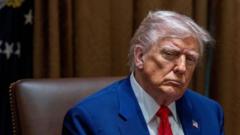Donald Trump recently introduced an expansive tariff initiative designed to significantly alter the international trade landscape and challenge conventional economic alliances. However, following a surprising 90-day suspension of heightened tariffs on numerous countries, the question arises: Are Trump's trade ambitions closer to fruition? Here we delve into five critical objectives he outlined and their current status.
1) **Revamping Trade Agreements**
TRUMP'S VIEW: For too long, America has been exploited by various nations, both allies and adversaries alike.
Trump's initial tariff strategy introduced widespread tariffs that affected almost every trading partner, causing immediate reactions worldwide. The administration has touted communication from over 75 global leaders seeking trade concessions in light of the looming tariffs. Ongoing negotiations with countries like South Korea and Japan could lead to favorable agreements for the U.S.
TAKEAWAY: As the deadline for negotiations approaches, the active dialogue suggests Trump might secure some concessions, although firms will remain cautious moving forward.
2) **Revitalizing Domestic Manufacturing**
TRUMP'S VIEW: We will restore jobs and factories to American soil.
Historically, Trump has promoted tariffs as a tool to rejuvenate America’s manufacturing sector by protecting it from international competition. Yet, the fluctuating nature of tariff implementation creates uncertainty, which could hinder substantial investments in reshoring.
TAKEAWAY: The unpredictability surrounding tariff policies may compel businesses to adopt a wait-and-see stance, delaying major commitments.
3) **Confronting China**
TRUMP'S VIEW: China has been unfairly benefitting from U.S. trade policies.
The latest tilt in Trump’s tariffs particularly aims at China, whose trade practices the administration has deemed detrimental. However, the ambitious confrontation carries substantial risks, as it may alienate crucial allies and escalate economic confrontations.
TAKEAWAY: Although Trump might want a trade showdown with China, the strategic fallout could complicate America's position on the global stage.
4) **Increasing Federal Revenue**
TRUMP'S VIEW: We will harness the revenue generated by tariffs to reduce taxes and the national debt.
Trump has previously claimed that significant tariff revenues can help address fiscal challenges. Projections suggest that a continued 10% tariff could potentially yield $2 trillion over a decade, juxtaposed against the costs of tax cuts imposed in recent legislation.
TAKEAWAY: Should tariffs remain in place as proposed, the government could see a boost in revenue; however, the long-term impact of domestic production shifts on this revenue remains uncertain.
5) **Lowering Prices for Consumers**
TRUMP'S VIEW: Increased home production will lead to more competition and subsequently lower consumer prices.
While Trump argues that his tariff policy could reduce costs for American consumers, many economists predict the opposite. Tariffs often inflate import prices, leading to higher costs for households, significantly impacting vulnerable populations.
TAKEAWAY: Rising consumer prices could jeopardize Trump's political standing as they challenge the notion of a "golden age" for American consumers he envisions.
In summary, while Trump's tariff initiatives have generated some immediate action and negotiations, the fluctuating landscape and resultant economic uncertainties present formidable hurdles to achieving his broader trade goals. The next steps will likely determine how these objectives manifest in practice.


















